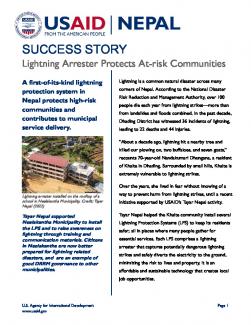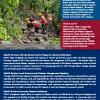Lightning Arrester Protects At-risk Communities
A first-of-its-kind lightning protection system in Nepal protects high-risk communities and contributes to municipal service delivery.
Lightning is a common natural disaster across many corners of Nepal. According to the National Disaster Risk Reduction and Management Authority, over 100 people die each year from lightning strikes—more than from landslides and floods combined. In the past decade, Dhading District has witnessed 36 incidents of lightning, leading to 22 deaths and 44 injuries.
“About a decade ago, lightning hit a nearby tree and killed our plowing ox, two buffaloes, and seven goats,” recounts 70-year-old Nandakumari Dhungana, a resident of Khalte in Dhading. Surrounded by small hills, Khalte is extremely vulnerable to lightning strikes.
Over the years, she lived in fear without knowing of a way to prevent harm from lightning strikes, until a recent initiative supported by USAID’s Tayar Nepal activity.
Tayar Nepal helped the Khalte community install several Lightning Protection Systems (LPS) to keep its residents safer; all in places where many people gather for essential services. Each LPS comprises a lightning arrester that captures potentially dangerous lightning strikes and safely diverts the electricity to the ground, minimizing the risk to lives and property. It is an affordable and sustainable technology that creates local job opportunities.
Dhruba Adhikari, Principal of Neelakantha Secondary School, feels relief knowing that the installation of an LPS will protect their 4,000 students, teachers and staff.
Dhruba said, “a few years ago, lightning damaged a house nearby and the teachers and students became stressed whenever there were thunderstorms and lightning. After installing the LPS, we all feel safer as it is protecting against damage and harm from lightning strikes. Schools need to be safe spaces for children.”
Local electricians gained confidence as they trained to maintain the system. Prakash Dhungana, an electrician, learned about LPS from a seven-day training organized by Tayar Nepal. More confident and motivated, he worked with a team of engineers to install a LPS in four public buildings after his training.
Tayar Nepal supported Neelakantha to install the LPS and to raise awareness on lightning through training and information, education, and communication materials. The activity also encouraged local youth to develop inclusive micro, small, and medium enterprises in LPS installation, while supporting Neelakantha to improve its disaster risk reduction and management (DRRM) Index Assessment scores and to develop tailored DRRM policies and plans to help them better cope with natural disasters, including lightning strikes.
Altogether, Tayar Nepal’s intervention in Neelakantha benefitted almost 3,500 people. Citizens in Neelakantha are now better prepared and safer from lightning related disasters, and other municipalities can look to them as an example of good DRRM governance.
Primary TextTayar Nepal supported Neelakantha Municipality to install the LPS and to raise awareness on lightning through training and communication materials. Citizens in Neelakantha are now better prepared for lightning related disasters, and are an example of good DRRM governance to other municipalities.


